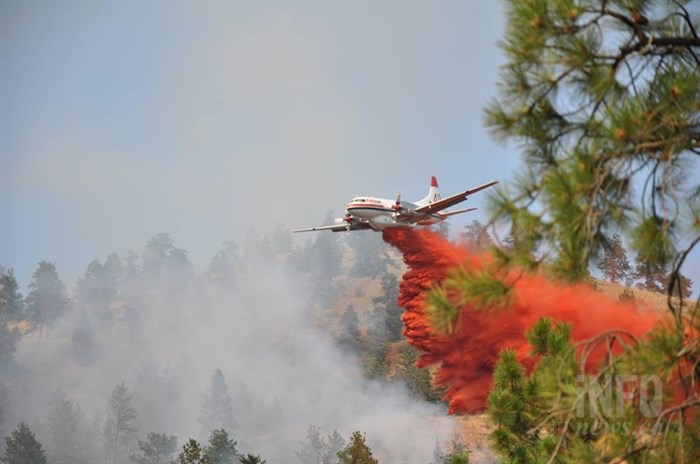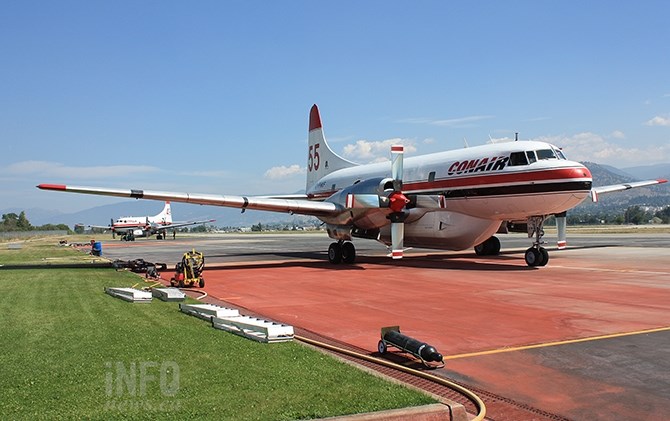
An air tanker drops fire retardant on a wildfire in West Kelowna.
Image Credit: FILE PHOTO
July 02, 2021 - 12:00 PM
PENTICTON - Residents whose structures are saved from wildfire by air tanker drops will no doubt breathe a sigh of relief the fire suppressing service was available, but may also have concerns about what that rather sinister looking dark-red substance is that stopped the flames dead in their tracks.
Mark Campbell with ICL Performance Products Canada says not to worry. His company manufacturers the fire retardant used by the B.C. Wildfire Service.
Campbell spent 30 years with the Saskatchewan Wildfire Management air attack service prior to joining ICL.
“I’ve used this stuff for decades. It’s mostly fertilizer," he says of his company’s product known as Phos Chek. "It’s over 90 per cent 11-37-0 fertilizer, the same stuff you buy to put on your lawn."
But what makes the powder bright red?
"The red colour is simply iron oxide or rust," he says. "That’s so the guys can see it in the trees and on the ground, because it’s important you have a continuous line of retardant."
Campbell says there are other minor ingredients in the powder, like corrosion inhibitors, because the substance is going into an airplane.
“All the ingredients going into the product have been pre-tested for environmental standards that have been agreed to by North American fire agencies.”
Campbell says the concentrate is 93 per cent fertilizer, then cut with water, which results in about a 12 per cent solution of the fertilizer.
“When used as directed, environmental and health risks are minimal,” Campbell says.

It's easy to keep the grass green at Penticton's B.C. Wildfire Service Air Tanker Base. The fire retardant carried by the air tankers is made up mostly of fertilizer.
(STEVE ARSTAD / iNFOnews.ca)
IS FIRE RETARDANT SAFE?
His company’s products are approved by the USDA in the United States for use on landscape and he says the product has been extensively tested.
Campbell says in rare cases, retardant finding its way to a water source may cause short term issues for aquatic organisms, but only rarely does that happen.
There are no reported health risks from ingestion by grazing animals, but if domestic pets or livestock appear to be affected by exposure, the animals should be taken to a veterinarian for examination.
He says foliage will initially react by turning brown from fertilizer burn, but when rain returns, the foliage will green up again and the red stains on the ground will disappear with time.
Fire retardant that has dried can form a film that bonds tightly to the surface on which it lands, which is intended to provide additional firefighting qualities.
The best method to clean-up retardant residue is to use a suitable brush and a soapy solution, followed by a thorough rinse. Campbell says pressure washers, while convenient, can result in iron oxide particles being pushed deeper into porous surfaces and is not recommended.
The retardant can also be slippery so care should be taken when working around drops.

FILE PHOTO - Large areas of the sagebrush are covered in fire retardant in Cache Creek, July 11, 2017.
(KIM ANDERSON / iNFOnews.ca)
HOW FIRE RETARDANT WORKS
The retardant works by forming a chemical firebreak in advance of an approaching fire. The solution coats a fuel source and as the fire gets closer, water in the solution evaporates.
The fire retardant component works by coating vegetation and other wildland fuels, making them non-flammable by altering the combustion process of cellulose in plants, trees and other vegetation.
Any remaining fire retardant residue will continue to act as a fire suppressant until rain washes it away.
The product is delivered to tanker bases in B.C. as a liquid concentrate. Prior to being loaded into air tankers, it is mixed with 5.5 parts water for each part of concentrate.
The retardant used in B.C, is blended and stored in Kamloops, or occasionally at the Phos-Chek facility in Fort Saskatchewan, Alta.
Tanker load sizes differ from one make and model of airplane to another, but a typical load taking off from one of the B.C. Wildfire Air Tanker Bases would carry about 18,000 pounds, equating to 1,750 gallons or 7,949 litres.
More information about Phos Chek fire retardant can be found at the company's website.
— This story was originally published on July 13, 2017.
To contact a reporter for this story, email Steve Arstad or call 250-488-3065 or email the editor. You can also submit photos, videos or news tips to the newsroom and be entered to win a monthly prize draw.
We welcome your comments and opinions on our stories but play nice. We won't censor or delete comments unless they contain off-topic statements or links, unnecessary vulgarity, false facts, spam or obviously fake profiles. If you have any concerns about what you see in comments, email the editor in the link above.
News from © iNFOnews, 2021